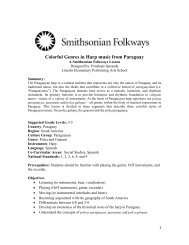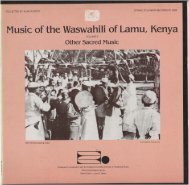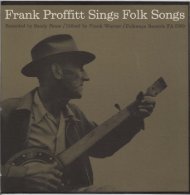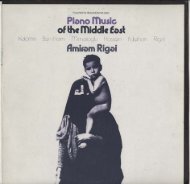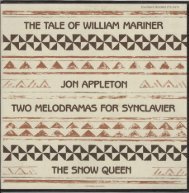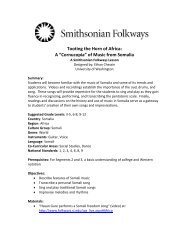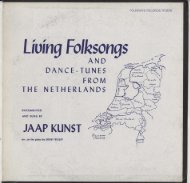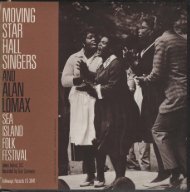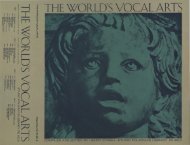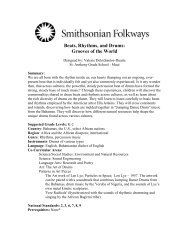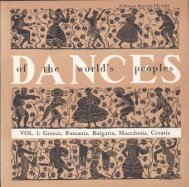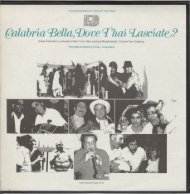Create successful ePaper yourself
Turn your PDF publications into a flip-book with our unique Google optimized e-Paper software.
flag in the Iwo Jima Memorial was a Marine, Ira Hayes, a member of the Pimatribe? Recently an Indian veteran visited Arlington National Cemetery lookingfor Indian graves but was discouraged to find only a nameless plaque genericallyacknowledging Indian partiCipation in our national wars.(A portion of the proceeds from the sale of this recording will be donated toa fund creating a national memorial in the nation's capitol honoring NativeAmerican veterans.)BackgroundThe War Dance and Roots of the Powwow.Because warfare was so central to much of North American Indiancultures, a large body of ceremOnial song and dance was associated with it.Even the earliest reports from explorers in the American interior mention thisfact. For example, the English explorer Jonathan Carver travelling in the westernGreat Lakes area in 1768 described "The War Dance" as follows :It is performed ... amidst a circle of warriors; a chief generally begins it, who moves from theright to the left, singing at the same time both his own exploits, and those of his ancestors.. . .Every one dances in his tum, and recapitulates the wondrous deeds of his family, tillthey all at last join in the dance.(Jonathan Carver, Travels Through the Interior Part of North America.. London, 1781, pp 269-71)As a European unaccustomed to the lively, often improvisatory style ofNew World dancing, Carver went on to describe some of its details, highlightingwhat he considered its "savage" aspect: "They throw themselves into every horribleand terrifying posture that can be imagined, rehearsing at the same time the partsthey expect to act against their enemies in the field ... . To heighten the scene, theyset up the same hideous yells, cries, and war-Whoops they use in time of action."The considerable time Indians spent preparing for and carrying out warfare wasaccompanied by song and dance: formerly, there were songs of recruitment for awar party, a song brought back by a war messenger, songs for dances precedingdeparture on the warpath, pledge songs sometimes to accompany ritual actionsdemonstrating bravery (such as eating dog meat), and a final send-off song ofdeparture. Singing continued while on the warpath: there was the song of thewar party leader, dance songs in the nightly camps, songs to prepare protectivemedicines to put on weapons and the body, and songs to be performed in thepitoh of battle. Each warrior had his own dream song for protection and had atthe ready his personal death song, should he become mortally wounded.When a victorious warparty returned from battle, an elaborate rite ofpassage symbolizing reincorporation into the tribe (see fig. 2) and cleansing ofcontamination through contact with death and blood took place in the ViCtory orScalp Dance. During this dance warriors would recount their exploits in song byperforming songs with texts co=emorating detailS of the battle. These songs,together with the scalps affixed to long poles, would then be taken to other villagesand "danced" with as well, as part of the general tribal celebration.Typical of such songs is one composed in May 1858 after a successful Ojibwayraid on the camp of the Dakota chief Cagobens on the Minnesota River. FrancesDensmore, in 1909, recorded an 89-year-old former warrior, reaching back halfa century in ·his memory to retrieve the song. Its words state, "At Cagobens' villagethe men are weeping; at Cagobens' village the women are weeping." Likemany such victory songs, the text is meant to humiliate the enemy and drawattention to his defeat. A similar song co=emorating Custer's defeat by theSioux and Northern Cheyennes in 1876 has the words: "Custer's wife is longawaiting his return. She is crying, looking this way." Another, the words "It isnot known where Custer lies. They are crying, searching for him." [See as wellEdgar Redcloud's "Lakota Little Bighorn ViCtory Songs" (track 3), and "FourHochunk (Winnebago) Service Songs" (tracks 8-11).]



